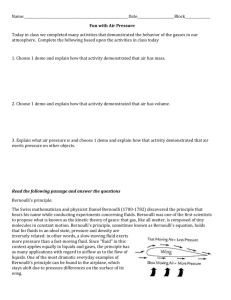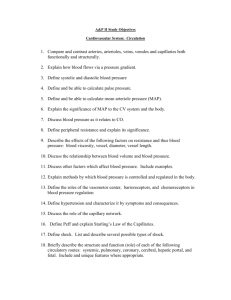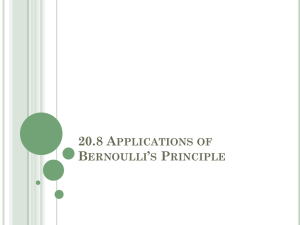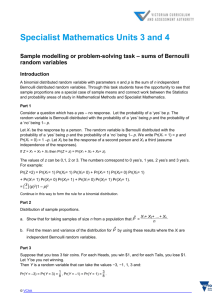HP Solids & Fluids Work Sheet #6 Equation of Continuity
advertisement
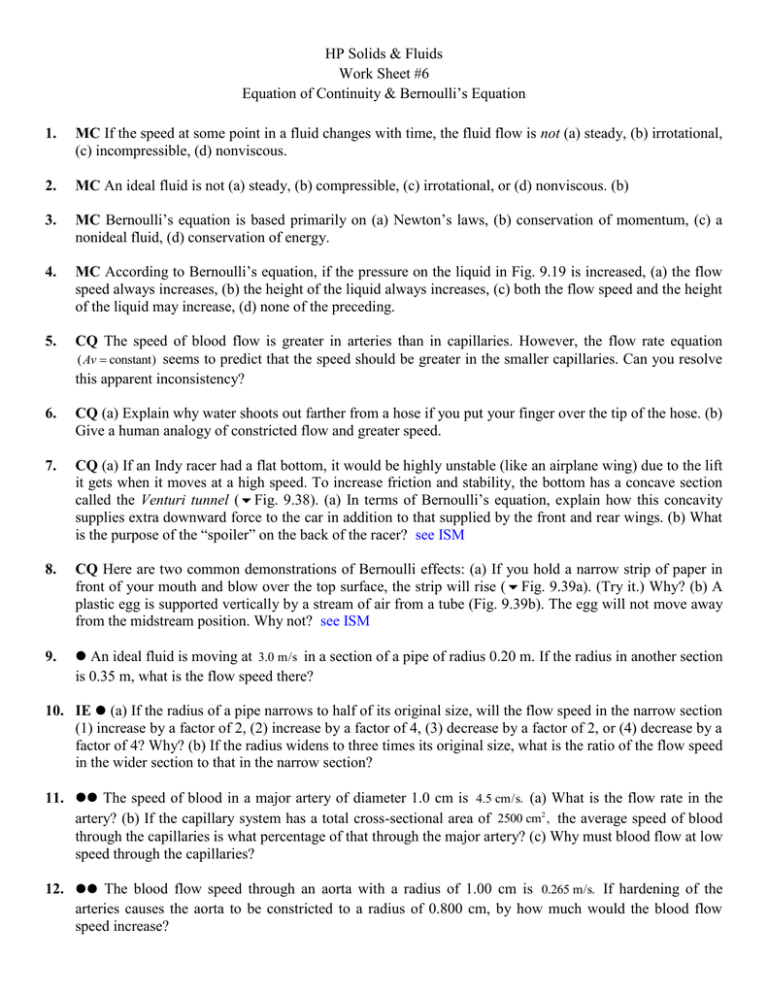
HP Solids & Fluids Work Sheet #6 Equation of Continuity & Bernoulli’s Equation 1. MC If the speed at some point in a fluid changes with time, the fluid flow is not (a) steady, (b) irrotational, (c) incompressible, (d) nonviscous. 2. MC An ideal fluid is not (a) steady, (b) compressible, (c) irrotational, or (d) nonviscous. (b) 3. MC Bernoulli’s equation is based primarily on (a) Newton’s laws, (b) conservation of momentum, (c) a nonideal fluid, (d) conservation of energy. 4. MC According to Bernoulli’s equation, if the pressure on the liquid in Fig. 9.19 is increased, (a) the flow speed always increases, (b) the height of the liquid always increases, (c) both the flow speed and the height of the liquid may increase, (d) none of the preceding. 5. CQ The speed of blood flow is greater in arteries than in capillaries. However, the flow rate equation ( Av constant) seems to predict that the speed should be greater in the smaller capillaries. Can you resolve this apparent inconsistency? 6. CQ (a) Explain why water shoots out farther from a hose if you put your finger over the tip of the hose. (b) Give a human analogy of constricted flow and greater speed. 7. CQ (a) If an Indy racer had a flat bottom, it would be highly unstable (like an airplane wing) due to the lift it gets when it moves at a high speed. To increase friction and stability, the bottom has a concave section called the Venturi tunnel (Fig. 9.38). (a) In terms of Bernoulli’s equation, explain how this concavity supplies extra downward force to the car in addition to that supplied by the front and rear wings. (b) What is the purpose of the “spoiler” on the back of the racer? see ISM 8. CQ Here are two common demonstrations of Bernoulli effects: (a) If you hold a narrow strip of paper in front of your mouth and blow over the top surface, the strip will rise (Fig. 9.39a). (Try it.) Why? (b) A plastic egg is supported vertically by a stream of air from a tube (Fig. 9.39b). The egg will not move away from the midstream position. Why not? see ISM 9. An ideal fluid is moving at 3.0 m/s in a section of a pipe of radius 0.20 m. If the radius in another section is 0.35 m, what is the flow speed there? 10. IE (a) If the radius of a pipe narrows to half of its original size, will the flow speed in the narrow section (1) increase by a factor of 2, (2) increase by a factor of 4, (3) decrease by a factor of 2, or (4) decrease by a factor of 4? Why? (b) If the radius widens to three times its original size, what is the ratio of the flow speed in the wider section to that in the narrow section? 11. The speed of blood in a major artery of diameter 1.0 cm is 4.5 cm/s. (a) What is the flow rate in the artery? (b) If the capillary system has a total cross-sectional area of 2500 cm2 , the average speed of blood through the capillaries is what percentage of that through the major artery? (c) Why must blood flow at low speed through the capillaries? 12. The blood flow speed through an aorta with a radius of 1.00 cm is 0.265 m/s. If hardening of the arteries causes the aorta to be constricted to a radius of 0.800 cm, by how much would the blood flow speed increase? 13. Using the data and result of Exercise 90, calculate the pressure difference between the two areas of the aorta. (Blood density: 1.06 103 kg/m3 . ) 14. In a dramatic lecture demonstration, a physics professor blows hard across the top of a copper penny that is at rest on a level desk. By doing this at the right speed, he can get the penny to accelerate vertically, into the airstream, and then deflect it into a tray, as shown in Fig. 9.40. Assuming the diameter of a penny is 1.80 cm and it has a mass of 3.50 g, what is the minimum airspeed needed to lift the penny off the tabletop? Assume the air under the penny remains at rest. 15. A room measures 3.5 m by 4.5 m by 6.0 m. If the heating and air-conditioning ducts to and from the room are circular with diameter 0.30 m and all the air in the room is to be exchanged every 12 min, (a) what is the average flow rate? (b) What is the necessary flow speed in the duct? (Assume that the density of the air is constant.) 16. A inverted wing is used on race cars to increase the down force an thus increase the frictional force holding the car to the surface of the race track. The following wing has a surface area of 3.3 m2. The air pressure in the track area is 101,000 Pa and the air density (ρ) is 1.25kg/m3. a. Determine the down force when the air velocity is 67m/s above the wing and 75m/s below the wing. Answers 1. A 2. B 3. D 4. C 5. there are many capillaries 6. (a) smaller area, greater speed (b) arteries to capillaries 7. (a) The concave bottom makes the air travel faster under the car. This increase in speed will reduce the pressure under the car. The pressure difference forces the car on to the ground more to provide a greater normal force and friction for traction. (b) The spoiler is to produce a downward force for better traction or more friction. 8. (a) The air flow above the paper decreases the pressure there. This creates a pressure difference, and a lift force results. (b) The egg is kept aloft by the pressure of the air coming out of the end of the tube. As the eggs move to one side, there is a change in the flow speed around the egg that creates an inward pressure that makes the egg move back to midstream. 9. 0.98 m/s 10. (a) (2) increase by a factor of 4 (b) decrease by a factor of 9 3 11. (a) 3.5 cm /s (b) 0.031% (c) see ISM 12. 0.149 m/s 13. 53.6 Pa 14. 14.5 m/s 3 15. (a) 0.13 m /s (b) 1.8 m/s 16. 2340 N ( 540 lbs)

